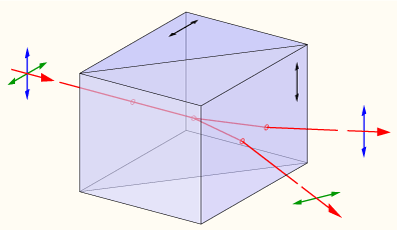.
Wollaston prism

A Wollaston prism
A Wollaston prism is an optical device, invented by William Hyde Wollaston, that manipulates polarized light. It separates randomly polarized or unpolarized light into two orthogonal, linearly polarized outgoing beams.
The Wollaston prism consists of two orthogonal calcite prisms, cemented together on their base (typically with Canada balsam) to form two right triangle prisms with perpendicular optic axes. Outgoing light beams diverge from the prism, giving two polarized rays, with the angle of divergence determined by the prisms' wedge angle and the wavelength of the light. Commercial prisms are available with divergence angles from 15° to about 45°.
See also
Retrieved from "http://en.wikipedia.org/"
All text is available under the terms of the GNU Free Documentation License

